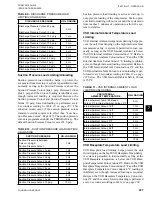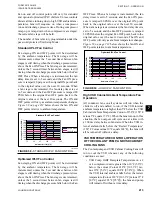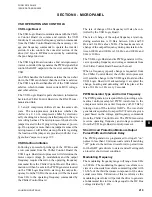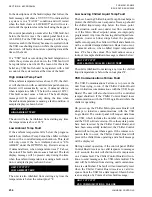
JOHNSON CONTROLS
220
FORM 201.23-NM2
ISSUE DATE: 09/25/2020
SECTION 8 - MICROPANEL
Maximum VSD Frequency
The maximum VSD frequency will vary for each chill-
er model. The microprocessor board determines the
frequency according to jumpers' factory installed in
the wiring on the J7 plug of the microprocessor board.
The location of these jumpers' is interpreted as a binary
value, which presently allows 7 speed selections plus a
default. The maximum frequency may vary from 178
Hz to 200 Hz. If the J7 plug is not installed, the speed
will default to 178 Hz. Details on the location of the
jumpers' and the associated maximum speed are pro-
vided in
Chiller Configuration Jumpers on page 195
VSD % Modulation
The voltage and frequency commands issued by the
VSD Logic Board microprocessor are determined
by the frequency command from the Chiller Control
Board. The VSD output is a PWM signal (
), which has effects on the motor comparable
to an AC voltage sinusoidal waveform. To change the
speed of an AC motor, the frequency of the AC volt-
age must be changed. Whenever frequency is changed,
the voltage is changed in a linear ratio. Maintaining a
relatively constant V/F ratio as speed changes assures
motor losses and overheating do not occur.
The output voltage of the VSD is not a sinusoidal
waveform. Instead, the PWM generator provides an
output that simulates a true AC waveform by repeti-
tively turning on and off the voltage to the motor to
create an average voltage that is equal to a lower AC
voltage at lower frequencies and a higher voltage at
higher frequencies. The PWM generator also changes
the % modulation of the waveform to simulate the fre-
quency change to maintain the V/F ratio with motor
speed changes.
The PMW generator is programmed to essentially op-
erate a linear volts/Hz ratio over the 0 Hz to 200 Hz
frequency range. The complex control algorithm modi-
fies the voltage command to boost the voltage of the
V/F ratio at lower speeds to provide additional torque.
The 100% modulation operating point occurs at a fun-
damental frequency of 189.6 Hz. As the output fre-
quency increases above 189.6 Hz, the drive operates in
an over-modulated mode. For example, at 200 Hz fun-
damental modulating frequency the PWM waveform is
over-modulated by approximately 18%. This will yield
a fundamental output line to line voltage applied to the
motor terminals at maximum output frequency that is
equal to the input line to line voltage applied to the
drive (provided the DC Bus current remains continu-
ous).
VSD Cooling and Cooling Loop
The VSD generates heat in the IGBT power modules
and the SCR/Diode assemblies, which must be re-
moved. The heat not only heats the modules but also
the Micro/VSD cabinet.
The VSD is cooled by a glycol loop and circulating
pump. The glycol cooling loop feeds a liquid cooled
heatsink called a chillplate that cools the IGBT’s and
SCR/Diode modules. The coolant is pumped by a cir-
culator pump through the heatsink where it absorbs
heat in several passes of tubes on the lower rows of
the inside condenser coils where the condenser fans re-
move the heat picked up from the modules. The cool-
ant is then pumped back to the modules. The glycol
loop also provides cooling for the Micro/VSD cabinet.
The baseplates of the power components are mounted
to the glycol cooled heatsinks in the cooling loop. The
cooling loop also circulates the glycol through a cool-
ing coil in the cabinet. A fan blows air from the cabinet
across the cooling coil to cool the electronics in the
cabinet.
Never run the glycol pump without cool-
ant! Running the glycol pump without
coolant may damage the pump seals
Always fill the system with approved cool
-
ant to avoid damage to the pump seals and
other components.
Heat transfer characteristics of the cool-
ant are very critical. Substituting coolant
or adding water will result in cooling loop
performance loss and chiller shutdown.
The glycol coolant level in the VSD cooling system
should be maintained between 9 and 15 inches (23 and
38 cm) from the top of the fill tube. This check should
be performed prior to running the pump. The pump can
be test run by placing the chiller in Service Mode. It
is advisable to fill the tube to the required level be-
fore starting the glycol pump because it may empty
when the pump starts. The level should be topped off
as needed while running. Be sure to re-install the cap
before stopping the glycol pump to avoid overflowing
the fill tube when the glycol pump is turned off.
Glycol coolant has a defined operating life. System
coolant should be changed 5 years from date of ship-
ment of the equipment. Mixing other coolants or water
with the special glycol will reduce the life of the cool-
ant, and cause VSD overheating and damage.
Содержание YCIV Series
Страница 14: ...JOHNSON CONTROLS 14 FORM 201 23 NM2 ISSUE DATE 09 25 2020 THIS PAGE INTENTIONALLY LEFT BLANK...
Страница 32: ...JOHNSON CONTROLS 32 FORM 201 23 NM2 ISSUE DATE 09 25 2020 THIS PAGE INTENTIONALLY LEFT BLANK...
Страница 40: ...JOHNSON CONTROLS 40 FORM 201 23 NM2 ISSUE DATE 09 25 2020 THIS PAGE INTENTIONALLY LEFT BLANK...
Страница 50: ...JOHNSON CONTROLS 50 FORM 201 23 NM2 ISSUE DATE 09 25 2020 THIS PAGE INTENTIONALLY LEFT BLANK...
Страница 105: ...JOHNSON CONTROLS 105 SECTION 6 TECHNICAL DATA FORM 201 23 NM2 ISSUE DATE 09 25 2020 THIS PAGE INTENTIONALLY LEFT BLANK...
Страница 325: ...JOHNSON CONTROLS 325 FORM 201 23 NM2 ISSUE DATE 09 25 2020 NOTES...
















































